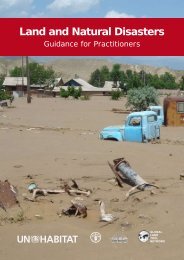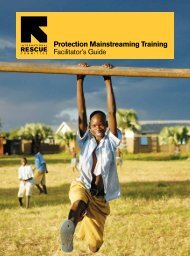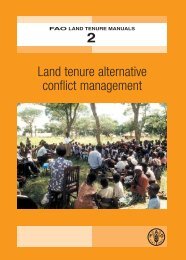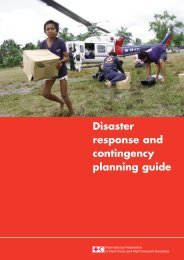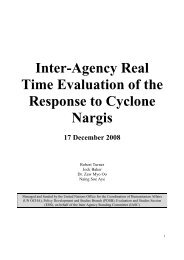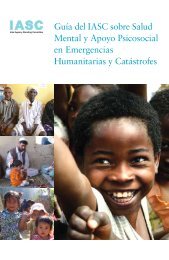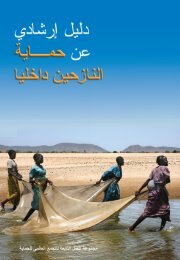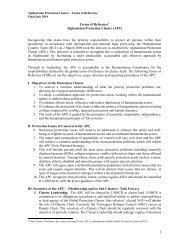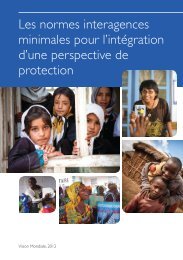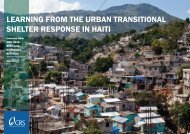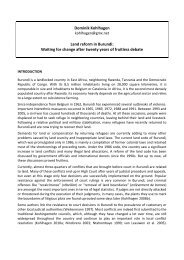Mid-Year Review of the Work Plan for Sudan 2012 - Global ...
Mid-Year Review of the Work Plan for Sudan 2012 - Global ...
Mid-Year Review of the Work Plan for Sudan 2012 - Global ...
Create successful ePaper yourself
Turn your PDF publications into a flip-book with our unique Google optimized e-Paper software.
54[2] NEEDS PROGRESS ANALYSIS | SECTOR RESPONSE UNITED NATIONS AND PARTNERSSUDAN MID YEAR WORK REVIEW PLAN | SUDAN <strong>2012</strong> WORK PLAN <strong>2012</strong>Outcomes (withcorresponding targets)Outputs (with corresponding targets)Indicators (with correspondingtargets and baseline)Achieved as mid-yearStatusObjective 3: Streng<strong>the</strong>n <strong>the</strong> capacity <strong>of</strong> national actors to efficiently and effectively manage <strong>the</strong> returns and reintegration process.National actors are ableto plan <strong>for</strong> and implementreturn and reintegrationprogrammes.Include, but not limited to:- Training programmes in return and reintegrationplanning; <strong>the</strong> principles <strong>of</strong> return; registrationand returnee pr<strong>of</strong>iling; convoy managementand transportation assistance; protection, safetyand security issues.- Data collection and pr<strong>of</strong>iling <strong>of</strong> IDPs andreturning populations to support return andreintegration planning.Number <strong>of</strong> people trained inregistration activities.Number <strong>of</strong> people trained in transportationassistance (movementoperations).Number <strong>of</strong> people trained in planning<strong>for</strong> return and reintegrationassistance.Staff trained fromCommission <strong>for</strong> Voluntaryand Humanitarian <strong>Work</strong>sand within <strong>the</strong> returneecommunity on protectionmonitoring and distribution<strong>of</strong> assistance.On TrackWATER, SANITATION ANDHYGIENE (WASH)àrequire immediate extension. Fur<strong>the</strong>r, critical WASH servicegaps have been reported in most <strong>of</strong> <strong>the</strong> returnee areas andrural communities.Summary <strong>of</strong> updated sector response planLead agency(s)Government leadSector memberorganizationsProjectsFunds requestedFunds requested per prioritylevelFunding to dateContact infoChanges in needsUNICEFPublic Water Corporation (Ministry <strong>of</strong> Water Resources andIrrigation)AAR Japan; DCA; FPDO; JASMAR; MAG; NMIAD;RHF;El Ruhama; Sibro; Twasol Al Amal Charity Organization;UNMAS-S49 projects$94.0 million (original)$94.2 million (revised at mid-year)$57.3 million (high)$36.9 million (medium)$14.1 million (15% <strong>of</strong> requirements)Ram Koirala, rkoirala@unicef.org;Daudi Bikaba, dbikaba@unicef.org;Categories and disaggregated numbers <strong>of</strong> affectedpopulation and beneficiariesPeople in needTargeted beneficiariesCategory Female Male Total Female Male TotalIDPs andreturneesRefugees all<strong>Sudan</strong>Affectedcommunities1,208,000 1,161,000 2,369,000 1,208,000 1,161,000 2,369,00042,000 42,000 84,000 42,000 42,000 84,000865,000 865,000 1,730,000 865,000 865,000 1,730,000Total 2,068,000 2,115,000 4,183,000 2,068,000 2,115,000 4,183,000Tensions between <strong>Sudan</strong> and South <strong>Sudan</strong> resulted in newdisplacements in South Kord<strong>of</strong>an and Blue Nile states. Jointassessments conducted in South Kord<strong>of</strong>an state in affectedareas where access has been granted indicates that 39,129IDPs had no adequate WASH services because <strong>of</strong> brokenwater supply infrastructures and poor hygiene and sanitationpractices.The sporadic clashes between Government <strong>for</strong>ces and armedmovements, as well as inter-tribal tensions in Darfur, resultedin new displacement in in both North and South Darfur. Shortage<strong>of</strong> water supply has been observed in some IDP camps, as<strong>the</strong> camps have grown out <strong>of</strong> <strong>the</strong> initial design and <strong>the</strong> waternetworks become inadequate to meet <strong>the</strong> current need andIn addition, due to <strong>the</strong> poor rainfall during last year, <strong>the</strong> waterlevels <strong>of</strong> many water sources have drastically declined resultingin a significant reduction <strong>of</strong> yield. This has necessitated <strong>the</strong>increase <strong>of</strong> working hours <strong>of</strong> many motorized water sourcesto cope with <strong>the</strong> increasing water demand in <strong>the</strong> IDP camps.Sector partners are investigating vulnerable aquifers in IDPscamps to determine <strong>the</strong> effect <strong>of</strong> drought on <strong>the</strong>se watersources; however, most <strong>of</strong> <strong>the</strong> electronic loggers installed inobservation wells in <strong>the</strong> IDPs camps are also not operating dueto technical problems.Preparedness ActivitiesA preparedness plan has been produced <strong>for</strong> <strong>the</strong> South <strong>Sudan</strong>esereturnees and <strong>the</strong> high risk border areas. In <strong>the</strong> plan, lifesavingemergency WASH supplies were expected to be prepositionedto support a total <strong>of</strong> 1,965,000 people in <strong>the</strong> statescovered by <strong>the</strong> contingency plan. The total funding required<strong>for</strong> preparedness activities <strong>for</strong> <strong>2012</strong> is $13.2 million <strong>of</strong> which$6.2 million was received. The need <strong>for</strong> <strong>the</strong> next six months willbe $7.0 million.Achievements as <strong>of</strong> 15 May <strong>2012</strong>The Sector provided sustained access to improved watersupply <strong>for</strong> 2.8 million IDPs and affected communities through<strong>the</strong> operation, maintenance and rehabilitation <strong>of</strong> existingservices. An additional 165,055 people have gained accessto improved water supply through <strong>the</strong> construction <strong>of</strong> newfacilities. Meanwhile, six communities in South Darfur weredeclared to be free from open defecation and 241,208 peoplewere provided access to improved sanitation trough <strong>the</strong>construction <strong>of</strong> new sanitation facilities and <strong>the</strong> rehabilitation<strong>of</strong> damaged sanitation facilities.In terms <strong>of</strong> hygiene education, 1.9 million people were reachedwith hygiene education messages and 1.7 million peoplehave been served through solid waste management activities.Moreover, almost 1.1 million people have been served byvector control measures in IDPs camps and risks areas.Capacity building activities have been carried out <strong>for</strong> 5,850people by community members and WASH sector staff.



